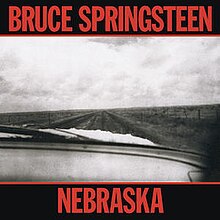Nebraska (album)
| Nebraska | ||||
|---|---|---|---|---|
 |
||||
| Studio album by Bruce Springsteen | ||||
| Released | September 30, 1982 | |||
| Recorded | Mostly January 3, 1982 at Springsteen's Colts Neck, New Jersey bedroom | |||
| Genre | Folk,heartland rock | |||
| Length | 40:50 | |||
| Label | Columbia | |||
| Producer | Bruce Springsteen | |||
| Bruce Springsteen chronology | ||||
|
||||
| Singles from Nebraska | ||||
|
||||
| Professional ratings | |
|---|---|
| Review scores | |
| Source | Rating |
| AllMusic | |
| Chicago Tribune | |
| Encyclopedia of Popular Music | |
| MusicHound Rock | 3.5/5 |
| Q | |
| Rolling Stone | |
| The Rolling Stone Album Guide | |
| The Village Voice | A− |
Nebraska is the sixth studio album by Bruce Springsteen. The album was released on September 30, 1982, by Columbia Records.
Sparsely-recorded on a cassette-tape Portastudio, the tracks on Nebraska were originally intended as demos of songs to be recorded with the E Street Band. However, Springsteen ultimately decided to release the demos himself. Nebraska remains one of the most highly regarded albums in his catalogue.
The songs on Nebraska deal with ordinary, blue collar characters who face a challenge or a turning point in their lives, but also outsiders, criminals and mass murderers with little hope for the future — or no future at all, as in the title track, where the main character is sentenced to death in the electric chair. Unlike with his previous albums, very little salvation and grace is present within the songs. The album's uncompromising sound and mood combined with its dark lyrical content has been described by music critic William Ruhlmann as "one of the most challenging albums ever released by a major star on a major record label."
Initially, Springsteen recorded demos for the album at his home with a 4-track cassette recorder. The demos were sparse, using only acoustic guitar, electric guitar (on "Open All Night"), harmonica, mandolin, glockenspiel, tambourine, organ, synthesizer (on "My Father's House") and Springsteen's voice. The songs themselves also have sparse composition, and many of the songs are simple three chord songs. After he completed work on the demos, Springsteen brought the songs to the studio and recorded the album with the E Street Band. However, he and the producers and engineers working with him felt that a raw, haunted folk essence present on the home tapes was lacking in the band treatments, and so they ultimately decided to release the demo version as the final album. Complications with mastering of the tapes ensued because of low recording volume, but the problem was overcome with sophisticated noise reduction techniques.
...
Wikipedia
